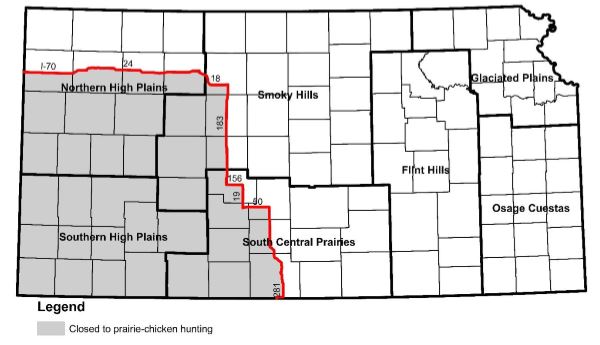Pheasant hunting in Kansas should be fair to locally good this year. Pheasant densities had been slowly but surely recovering between 2013 -2016 with a few areas reaching relatively high densities. A late spring blizzard across much of western Kansas in 2017 reduced nesting success resulting in a decline in the 2018 pheasant crow survey. This was largely attributed to declines in the Southern High Plains region hit hardest by the storm.
Over-winter precipitation was limited this year resulting in short wheat and concern for nesting prospects. Heavy spring and summer showers greatly improved vegetative cover for nesting later in the season, but also limited nest success. These conditions shifted peak pheasant hatch later into June and July than normal.
Excessive rain delayed wheat harvest—which typically benefits pheasant production—but short wheat limited the usefulness of this cover this year. Roadside counts indicate that we are likely to see a below-average pheasant population this year. The combination of heavy cover and an estimated later peak hatch may have reduced the number of detectable birds on the counts, but generally survey conditions were ideal.
Last year Kansas reported the second highest pheasant harvest in the country. Despite reduced numbers, Kansas continues to maintain one of the best pheasant populations in the country and the fall harvest should again be among the leading states. The best areas this year will likely be in the northern
half of the Kansas pheasant range with areas of high densities also found in central and far southwestern regions.
Here is region-by region pheasant summary, preceded by a map of Kansas’s upland gamebird zones.

NORTHERN HIGH PLAINS
<Public Land: 12,889 acres. WIHA: 410,184 acres.>
Pheasant hunting opportunities should remain fair to good, but there will be fewer birds in the area than last year. The spring pheasant crow survey index was the highest regional index this year but remained below-average for the region. There was a significant decline in the regional pheasant index on the roadside survey this year compared to 2017. Production was assumed to be negatively impacted by heavy rainfall throughout the summer, which was confirmed by ongoing research in the region. The highest densities will be found in the northern half of the region, particularly the northeastern counties.
SMOKY HILLS
<Public Land: 75,576 acres. WIHA: 362,936 acres.>
Pheasant hunters should expect fair to good opportunities throughout much of the region. The spring crow survey saw a slight decrease, followed by a decrease in the summer roadside counts. Despite this decrease, the Smoky Hills had the highest regional roadside density in the state. Regional harvest estimates were highest in the Smoky Hills last year but are expected to decrease with decreased densities. The northern half of the region contained the highest roadside counts; however, counties in the southwestern portion of the region along the border of the South-Central Prairies observed good counts as well.
GLACIATED PLAINS
<Public Land: 60,559 acres. WIHA: 66,966 acres.>
Opportunities will remain poor with hunting opportunities existing only in pockets of habitat, primarily in the northwestern portion of the region or areas managed for upland birds. Spring crow counts this year declined from 2017. Roadside surveys showed increases; however, only 2 routes observed pheasants in 2018. Pheasant densities across the region are typically low, especially relative to other areas in central and western Kansas.
FLINT HILLS
<Public Land: 128,371 acres. WIHA: 67,497 acres.>
This region is on the eastern edge of the primary pheasant range in Kansas and offers limited opportunity. Pheasant densities have always been relatively low throughout the Flint Hills and the highest densities are typically found on the western edge of the region. While the spring crow counts remained stable this year, the summer roadside survey had limited observations and indicated a decrease. The best opportunities will be found in the northwest portion of the region along the Smoky Hills.
SOUTH-CENTRAL PRAIRIES
<Public Land: 19,534 acres. WIHA: 61,547 acres.>
Pheasant hunters should expect a fair to good season this year. The spring crow survey indicated a decline from 2017. However, the summer roadside survey showed a slight increase and was the only notable improvement from last year. Pheasants will be readily found in the traditional areas of the region. Based on roadside surveys, opportunities are expected to remain similar. The highest pheasant densities will be in the northern tier of counties along the border of the Smoky Hills region.
SOUTHERN HIGH PLAINS
<Public Land: 111,079 acres. WIHA: 189,255 acres.>
Pheasant hunting will remain fair to good, with bird numbers similar to last year. The pheasant crow index decreased this spring after heavy spring snowfall impacted nesting success in 2017. Roadside surveys showed slight declines in the region, after heavy rainfall throughout spring and summer likely decreased production. The highest densities will be in the western half of the region where the rainfall wasn’t as extreme.